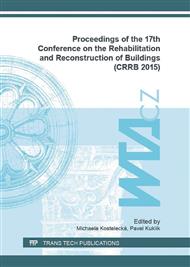p.165
p.171
p.179
p.186
p.192
p.196
p.201
p.207
p.213
Characterisation of Micoorganism from Individual Layers of the Building Envelope (ETICS) and Methods of their Sampling
Abstract:
The current situation of contact insulation systems from 80s and 90s is fallback and they do not correspond with current valid technical norm. The almost case is necessary refurbishment of building envelope or performance of additional insulation. The question "what ETICS hides inside" occurs, and whether the removal is necessary or whether the making of additional insulation directly on the current one is possible. This is connected with occurring of growth microorganism especially mold through building envelope. Our article is about problem of mold through building envelope esp. ETICS in territory of Czech Republic. The results show that the whole ETICS is contaminated with mold and there is a risk that if there are appropriate conditions for the fungus in building envelope and the newly remade ETICS will be attacked, then it will be the danger to the health of the users of building. In our research, we have evaluated and verified sampling method for the characterization of biodeteriogens which are accessible and user friendly for public.
Info:
Periodical:
Pages:
196-200
Citation:
Online since:
September 2016
Authors:
Keywords:
Price:
Сopyright:
© 2016 Trans Tech Publications Ltd. All Rights Reserved
Share:
Citation:


